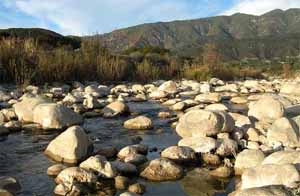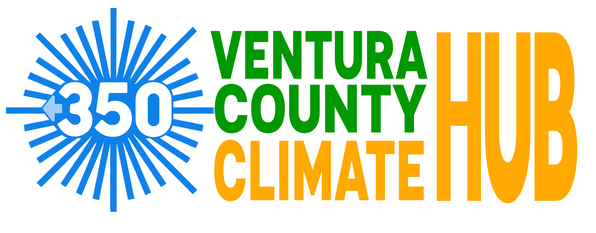350 Ventura County Climate Hub Suggestions for Policies
Chapter 10 – Water Resources, General Plan Update 
Includes Water Supply, Wastewater and Stormwater Management, because the climate cannot be stabilized without drawing down legacy carbon already in the atmosphere and carbon cannot be sequestered without water to grow soil microbes, plants (and animals). Water is life.
GOAL A: Prevent risky development in floodplains through agreement among all jurisdictions toward the required zoning and setbacks specific to each watershed to prevent inappropriate development in floodplains and relocate at-risk development avoiding investment in new or rebuilt levees that will not hold up under new flood predictions.
POLICIES
- Anticipate increasingly extreme weather due to climate change with increasing state restrictions and plan for worst case scenarios to assure that development in floodplains does not rely on levees or put human life at risk.
- Conduct a comparative cost-benefit analysis of rebuilding levees versus relocating homes and businesses and make cost-effective decisions for avoiding flood risks.
Background/Justification – The cities in Ventura County are in need of guidance and oversight to stop approving development in floodplains, particularly along the Santa Clara River. The Santa Clara River levee rebuild (SCR1) will cost the county $42 million and the engineer said it will be sacrificed in a 100 year event. It makes more sense to invest that money to slow the flow of upland sources and move the inappropriate development out of harm’s way.
GOAL B: Restore small water cycles in eroded and desertified landscapes and open spaces to recharge aquifers, maintain the integrity of ecosystems, support restoration of soil-carbon sponge and revegetation with perennials and grasses that sequester carbon, preserve the physical integrity of receiving waters by managing stormwater runoff at or close to the source, reduce flooding and stream channel degradation from erosion and sedimentation, improve water quality, increase water supply, assure protected habitat for re-establishment of trout and beaver, and enhance the recreational and aesthetic value of natural resources.
POLICIES
- Provide a collaborative framework representing all stakeholders and authorities to develop a low impact development plan with small and large scale water restoration projects.
- Maximize groundwater aquifer recharge through stormwater management to supply a minimum of 30 percent of total water use.
- Encourage development of upland watershed management plans that rely on local resources and labor, natural cycles, innovative treatment techniques and energy-saving methods to convert watershed processes toward bioretention, infiltration and interflow that support natural and vegetative covers and allow the natural supply of sediment to reach receiving waters.
- Promote best practices for restoration of small water cycles across jurisdictions that identify sites suitable for a wide range of small cumulative on-site water management measures including upland catchments and diversions to restore small water cycles that support increased vegetation for carbon sequestration, beaver, and movement of trout.
- Require pervious or permeable pavements on all appropriate new parking lots over some minimum size.
- Set low impact development goals and strategies such as disconnected hydrologic flow paths, reduction of impervious areas, functional landscaping, and grading to maintain natural hydrologic functions that existed prior to development, such as interception, shallow surface storage, infiltration, evapotranspiration, and groundwater recharge.
PROGRAMS
Rain for Climate Program. To help achieve a countywide Climate Action Plan goal to draw down a target amount of CO2 equivalent GHGs, develop and promote specific, common-sense recommendations for water conservation, to provide a best-practices repository for stormwater management and rainwater harvesting, stories, tips and successes building on experiences of community members that have implemented water conservation and soil-carbon sequestration solutions, tools and guidelines for stormwater and rainwater harvesting solutions, and learning experiences for individuals, organizations.
Business Carbon Sink Collaborative . To facilitate learning and achievement among businesses toward water conservation and carbon sequestration objectives by providing justifications for water conservation and carbon sequestration as economic opportunities and investments and by providing current lists of vendors and products for residential and small-scale commercial water conservation, stormwater management, and revegetation projects.
Justification-Deforestation, erosion, urbanization and the the conventional management of working and natural lands damages natural land-based water cycles. California is experiencing a chain reaction of degraded open space, depletion of groundwater, decimation of vegetation, effects from wildfires and extreme heat, increased albedo effect, and a major contributor to global warming. A global program is required beyond the cessation of greenhouse gas emissions to restore local hydrological cycles with practices that build the soil-carbon sponge to support perennial vegetation.
GOAL C: Develop local water supplies, including groundwater recharge and recycled water, in a countywide sustainability master plan with resource strategies to maximize local water resources that will limit use of imported water to ten percent of total water use.
POLICIES
- 30 percent of water to be supplied by groundwater. Provide leadership and facilitation for a countywide program to increase groundwater recharge using storm water and dry-weather runoff to assure groundwater basins supply at least 30% of total water use.
- Maximum 10 percent imported water. Limit imported water to 10 percent of total water use countywide and encourage desalinization to replace imported water as it becomes more scarce from the drought impacts of climate change.
- 40 percent of water to be supplied by recycled wastewater. Maximize the reuse of recycled water to achieve at least 40% of total water use to enhance reliability and reduce dependence on imported water.
- Tiered pricing. Require water districts to adopt appropriately configured tiered pricing structures combined with water budgets for water suppliers to reduce water demand over the long term, not just during periods of drought, to curtail wasteful activities and encourage investment in technologies that use less water, and water conservation.
- Track water use by account and provide technical assistance to high users. Establish average use standards per account based on 75 gallons per capita per day and incentivize compliance through billing and use monitoring with provision of on-site technical assistance as needed for accounts that quarterly exceed 30% of average water use or annually exceed 10% of average water use.
- Use reduction goal. Set target for water use reduction to exceed the per capita set by SB X7-7 Conservation Act of 2009 (standard of 20% compared to nominal 2005 levels by December 31, 2020).
- Water use reduction in new construction. Require adoption of voluntary CALGreen Tier 1 water-efficiency measures for new construction that includes mandatory stub out for greywater.
- Water conservation for existing buildings. Set countywide target for water conservation in existing buildings at 30% water use (compared to nominal 2005 levels by December 31, 2020) by implementing a program for water efficiency retrofit according to CALGreen Tier 1 water efficiency measures.
- Storage of rain water. Best practices will be disseminated for storage of rainwater from roots in barrels, tanks and cisterns.
- Non-fee based permitting process for rainwater capture and harvesting tanks, cisterns and other projects.
- Vector control education. Knowledge and non-toxic methods of mosquito control will be disseminated to minimize breeding in stored water.
- Curb cuts and rain gardens in new and existing developments. Street grading will be towards cub cuts and rain gardens for water storage catchments to prevent storm water from leaving the street. The county will cooperate with neighborhoods to regrade and install curb cuts and rain gardens, especially in the middle of culdesacs.
- Reduce water use for toilet flushing. Provide rebates for equipment and installation of EPA Water Sense certified toilets, urine diversion toilets (UDT), urine diversion flush toilets (UDFT), and urine diversion dry toilets (UDDT) and dry toilets to reduce or eliminate water use for flushing.
- Equipment will be installed so as not to waste water. Condensate from refrigeration and surplus water from filter systems will be put to use for landscaping.
- Regenerative farming. Promote use of regenerative organic farming methods to reduce toxins and sediment loads of surface waters and reduce water needs.
- No potable water in oil and gas production. Potable water will not be used for oil and gas production.
- Protect water from oil and gas production. Protect and preserve surface, stream, wetland, and groundwater resources from oil and gas drilling and produced wastewater transport, disposal or injection.
- Capture stormwater. Require that new development capture stormwater for onsite use to extent possible.
- Brackish water must be protected from pollution because it is easier to desalinate than sea water. Decontaminate or desalinate brackish aquifers in order to minimize need for imported water.
PROGRAMS
Optimum Basin Management Program (OBMP). A comprehensive countywide monitoring program for surface water, groundwater, and land subsidence, storm water and dry-weather runoff recharge improvements, salt and nutrient management, water quality improvements, the recovery of impaired groundwater for beneficial use, conjunctive use, pollution prevention from wastewater from oil production, and safe yield management to avoid overdraft.
Our Water World. Raise awareness of the connection between pesticide use and water quality and provide information to consumers at the point-of-purchase about integrated pest management (IPM) and less-toxic alternatives that do not pollute water. Provide community outreach / educational events in the stores to promote the availability of less toxic methods and products. Train store personnel in principles of regenerative organic strategies and sales techniques for less toxic products.
Water Demand Offset Expand amount of recycled water through an offset program like the program of Soquel Creek Water District.
Water Wise Survey Program
Landscape Rebate Program
Rebates on Efficient Appliances
Graywater Laundry to Landscape
Private Well Meters
Custom and Measured Rebate Program for Businesses
Meters and Submeters
Submeters
Private Well Meters
Irrigation Equipment Upgrades
California Irrigation Management Information System (CIMIS)
Irrigation system evaluation program
Drip and sprinkler irrigation scheduling calculators
Free material and equipment program: shower heads and timers, bathroom and kitchen aerators, pre-rinse sprayers (for homes and businesses),Table Tents for Restaurants “Drinking Water By Request”, Hotel “Linen Reuse” Cards
JUSTIFICATION
Using water consumes energy to clean and transport water and to handle wastewater. 60 percent of water use occurs indoors, primarily for toilets, clothes washers, showers, and faucets. Low-flush toilets and efficient washing machines can reduce water use by 19 and 17 percent respectively. Low-flow faucets and showerheads and efficient dishwashers can also contribute. Newer technologies can reduce water use within homes by 45 percent.
30 percent of home water use occurs outdoors, while another 10 percent is lost to leaks. Water use for irrigation can be reduced or eliminated by using captured rainwater, shifting to plants that do not require it, installing drip irrigation, or turning off the spigot entirely. Rebates on purchases of efficient appliances and fixtures, can encourage voluntary action.
GOAL D: Increase recycled water and greywater use
POLICIES
- Increase the use of recycled water. Increase over 2002 levels by at least XX acre-feet per year (afy) by 2020 and by at least xx afy by 2030.
- Increase the use of stormwater. Increase over use in 2007 by at least xx afy by 2020 and by at least xx afy by 2030.
- Industrial wastewater dischargers. Ensure that dischargers are managed to enhance the ability of water recycling plants to comply with National Pollutant Discharge Elimination System (NPDES) requirements; to protect the public, the environment, personnel and facilities; and recovery of wastewater treatment operations and maintenance costs.
- Subsidize measures to stop stormwater runoff. Federal fees for discharging stormwater will be spent in cooperation with neighborhoods to capture and harvest storm water in appropriate and use revenues to incentivize capture and pay for onsite treatment.
- Closed loop for industrial effluents. Ensure high quality reclaimed water by requiring closed loop for industrial effluents.
- Incentivize use of greywater. Reduce use of potable water for residential non-potable uses.
- Recognize urine in the same category as greywater. Urine is sterile and contains plant nutrients so it must be allowable to collected urine in
Urine Diversion Toilets to combine with other greywater for subsurface fertigation.
PROGRAM
Pretreatment and Source Control. Assure collection of wastewater to regional water recycling plants or to a Non-Reclaimable Wastewater System (NRW System) that exports industrial wastewater laden with high strength pollutants making the water not suitable for recycling at this time and assure that it is not stored near other sources of water.
BACKGROUND/JUSTIFICATIONS
With a local supply portfolio balanced among recycled water, captured stormwater, and groundwater, the county will survive catastrophes.
Pumping less water from faraway sources has environmental benefits. Moving water across the state uses huge amounts of energy. Leaving more water in the Delta, Owens Valley and the Colorado River watershed reduces ecological impacts and the carbon footprint of our water supplies.
Jurisdictions pay millions of dollars annually in federal permits for allowing stormwater runoff. By investing in helping neighborhoods create soil-carbon sponges along streets, those fees are reduced, water is returned to the aquifer and vegetation is supported that sequesters carbon. Culdesacs are generally 80 to 100 feet in diameter allowing space for large rain gardens that require regrading but do not require altering curbside sidewalks. Collaboration should be facilitated with homeowners who want to prevent flooding by redesigning the drainage on their street for stormwater catchment.
GOAL E: Increase water and wastewater efficiency in new developments and retrofits
POLICIES
- Develop an Integrated Regional Water Management Plan for more resilient, diversified and regenerative support of the county’s water resources.
- Adopt an Ordinance for Water Efficient New Development http://wdl.water.ca.gov/wateruseefficiency/landscapeordinance/
- Adopt Greywater-Ready Building and Safety requirements that assure that landscapes are more fire-resistant and defensible in a fire.Greywater-ready-buildings-model-ordinance.pdf
- Provide education about how to realistically size and design rainwater harvesting systems, for emergency rooftop irrigation in high-fire risk areas or for emergency back-up to offset potable irrigation demand. supplemental source to off-set potable irrigation demand.
GOAL F: Reduce water consumption
POLICIES
- Exceed water use reduction goal per capita set by SB X7-7 Conservation Act of 2009 (standard of 20% compared to nominal 2005 levels by December 31, 2020) establishing a countywide reduction target of 30% water use by implementing a program to retrofit existing buildings to achieve higher levels of water efficiency.
- Require adoption of voluntary CALGreen Tier 1 water-efficiency measures for new construction.
- Incentivize renovation of existing buildings to achieve higher levels of water efficiency; encourage existing buildings to retrofit with CALGreen Tier 1 water efficiency measures. Reduce water used in new construction by 100% in residential and 50% in non-residential development.
- Reduce water used in existing non-residential development by 10%.
GOAL G: Increase use of renewable energy in water and wastewater systems
POLICIES
- Use 100% renewable energy for 50 percent of all water production and/or conveyance by 2025 and by 100% by 2030.
- Install solar energy arrays at all water and wastewater plants.

